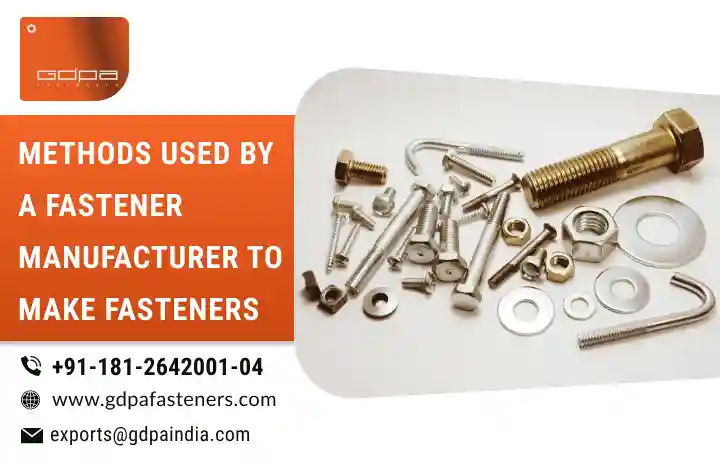
Fasteners are a set of tools that include nuts, screws, washers, and bolts that are used to hold different items together. Usually, fasteners are used to create a non-permanent joint. In other words, if you are using a fastener to join two different components, then they can be removed without any damage to any parts. On the other hand, the welded connection would not be considered the same. There are several fastener manufacturers (Hersteller von Verbindungselementen) that make fasteners of different sizes, however, they may follow a common technique to manufacture bolts, nuts, and screws. In today’s blog, we’ll share information on how manufacturers of fasteners make fasteners. Let’s get started:
How does a fastener manufacturer make fasteners?(Wie stellt ein Hersteller von Befestigungselementen Befestigungselemente her?)
Nuts, bolts, washers, screws, and other fasteners are made by using several processes. Basically, there are three common methods to produce fasteners, such as hot forging, cold forging, and machining. The method used to produce a fastener is determined by the metal, type, and volume. Certain metals have more elasticity and flexibility, and the type of metal impacts the forming procedure.
- Cold Forging
Cold forging is also considered cold roll forming, and it is the most common method of manufacturing fasteners because of its low waste and speed. It is quite similar to machining as it is done at or near room temperature to produce large quantities of fasteners efficiently, affordably, quickly, and consistently.
When fasteners manufacturers (Hersteller von Verbindungselementen) use the cold forging process, then the material’s crystal structure goes through some changes, becoming resistant and stronger. As a result, fasteners will have mechanical and physical properties after completing the process. The performance of cold forming depends on the fastener’s size to be manufactured.
- Hot Forging
Generally, hot forging is one of the most common methods for manufacturing bolts with large diameters that have a thread of size around M36 or more, and their length can be around 300mm and more. The material is heated up to a high temperature to make the material more flexible and then passed into a forging press. The temperature is determined by the bar material, tolerances, and geometry. With the help of hot forging, it is possible to make complex shapes with a high degree of temperature. Hot forging is also a process of making fasteners from titanium alloys and nickel-based alloys. Fastener suppliers (Anbieter von Verbindungselementen) use this technique to make large and complex-shaped fasteners.
- Machining
With the help of machining, manufacturers can deform metals to manufacture components and parts. A metal piece can be shaped or bent to match a required pattern or form by drilling, cutting, milling, turning, and grinding it. Unlike shaping and casting, machining works with metal at room temperature or it might be slightly higher. Superior tolerances, precision, and capacity to manufacture difficult shapes are all benefits of machining. Machining is a quite time-consuming process that is suitable for making a few fasteners. Despite this, there are a number of fastener suppliers in Germany (Anbieter von Verbindungselementen in Deutschland) that also follow these techniques to produce high-quality fasteners.
Types of Fasteners (Arten von Verbindungselementen)
- Nuts (Muttern)
Nuts are a small block of metal or material that commonly comes in hexagonal or square shape. Nuts contain internal threads to receive a bolt. Bolts and nuts (Schrauben und Muttern) are used together to join different components.
- Bolts (Schrauben )
Bolts are widely used fasteners. Generally, these tools are made from a thin rod of metal. Its top side has its head from where one can hold it easily. Opposite the head, there are threads to fix the components with the help of a nut.
- Screws (Schrauben)
Basically, screws are used to attack different parts of the machines. On screws, there are different types of threads. The diameter of screws is smaller than bolts. The maximum diameter of screws is up to 1/4”. Screw heads are of different types.
- Washers (Unterlegscheiben)
The washer’s shape is like a ring. Before tightening the bolt and nut, it is fitted on a bolt. The washer is used to ensure that the joint is tightened properly and makes it easy to unscrew the bolt and nut.
- Studs (Nieten)
Studs can be referred to as headless bolts. A stud is a long rod that has threads on both ends. Firstly, the stud is tightened in the hole of the substance or component to be attached to it and then a nut is tightened on it. Its primary benefit is that we can separate the upper part by losing the nut while keeping the lower part attached.
- Rivets (Nieten)
Rivets are used to join the jobs made of plates or sheets permanently. In the sheet metal work and boiler, it is used for making buckets and trunks. Usually, rivets are made from mild steel but sometimes they are made of copper, brass, aluminum, etc.
Summing Up
Now, you have an idea of how fasteners are made and what techniques are used by a fastener manufacturer (Hersteller von Verbindungselementen). In addition to this, the blog shares information on different types of fasteners along with their uses.